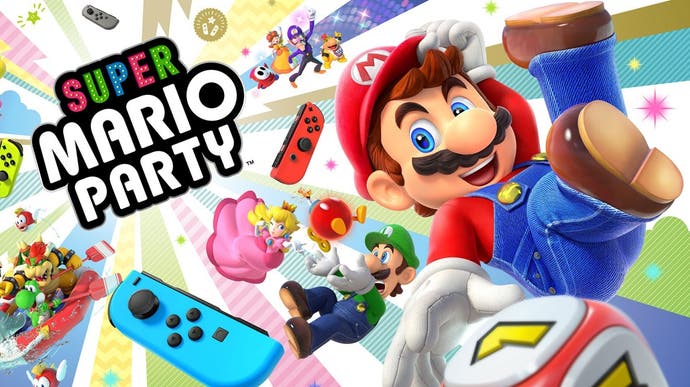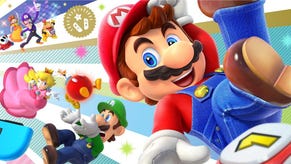Super Mario Party review - silly, slick and spotty return for Nintendo's madcap series
A birdo in the hand.
It's getting towards that time of the year again. With Christmas on the not-too-distant horizon, it will soon be time to consider which title will be the go-to choice for the festivities. For me, the criteria for a Christmas classic comes down to a few categories. Is it quick to learn? Is it humorous? Can I still play it after four glasses of sherry?
One potential answer to all of these questions is, of course, Super Mario Party. It's the 11th console entry in the series, so it's hardly Mario Party's first rodeo. But as the first for the Switch, the new game is also a chance for Nintendo to take the formula in a new direction. That much has been publicly promised, in fact - Nintendo is claiming that Super Mario Party represents a "complete refresh" of the series. And true to its word, Nintendo has certainly made the new game different. By combining elements of previous titles with new modes like River Survival and Sound Stage, this is most definitely a fresh take on the Mario Party formula.
But is it fun? Well, yes. Sort of.
Like most entries in the Mario Party series, if you're looking for a solid and dependable party game, this will absolutely do the job. The variety and silliness of the minigames is always a recipe for hilarity with friends, and Super Mario Party displays classic Nintendo charm. Yet despite the changes, some of the old Mario Party problems continue to linger, and it's unlikely to be a game you'll repeatedly return to in single-player mode. It does what it says on the tin, and does it well, but no more.
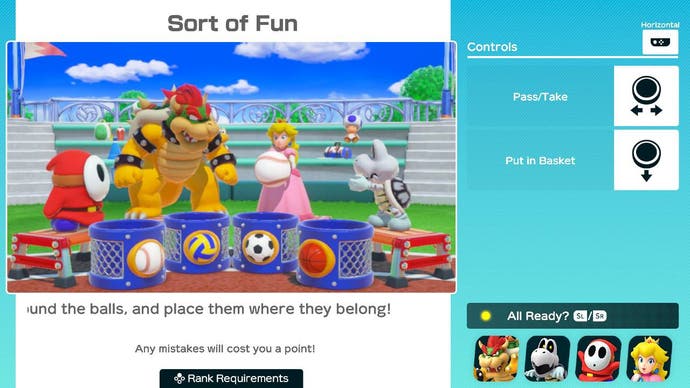
As Toad cheerfully informed me upon entering the party plaza, "it makes sense you would head straight for Mario Party," so I'll start by discussing the main 4-player Mario Party mode. Many fans will be delighted to hear Super Mario Party abandons the vehicle mechanic of its predecessors (which forced players to move around lumped together in a tiny cart). Instead, each player moves separately on a linear path, with some options to choose which route to take. The upside of this is increased competition, as players can make more tactical decisions. But the downside of ditching the cart is it revives one of Mario Party's oldest problems: the tedium of waiting for each individual to take their turn. Separate movement considerably slows the momentum between the minigames which form the heart of any Mario Party title. It's a trade-off that replaces one problem with another.
Another major change to the mechanics is the introduction of character-specific dice, of which I am a huge fan. Each Mario character has their own special die with unique properties, which not only gives players more tactical options, but ties the mechanic into the Mario world. The dice appear to be personifications of their characters; evil characters like Bowser, for instance, often carry high 10s on their dice, but also run the risk of losing three coins and a turn. Mario, meanwhile, has the world's most average character die with 1, 3, 3, 3, 5 and 6. Maybe I'm being a little harsh on Mario here.
Anyway, you're also not stuck with only one character die, as due to the return of the ally system, you can also choose from the dice of allies you find along the way. All you have to do is land on an ally space or pick up a buddy phone, and they will follow you around the board like a puppy. Again, this helpfully expands player movement options, and it's also rather charming to interact with the other Mario characters.

Now for the important bit, and the very foundation of Mario Party: the boards. There's a choice of four in this Mario Party game, with three available from the start and one (Kamek's Tantalizing Tower) which can be unlocked at a later point. It's a lower amount than many previous games in the series - although with the new modes and 80 new minigames, there's still enough variety overall that this doesn't feel like a major loss.
The boards themselves are, as ever, gorgeously presented. Megafruit Paradise is particularly vibrant, and reminded me of my days paddling around the tropics of Delfino Plaza in Super Mario Sunshine. More ominous is King Bob-omb's Powderkeg Mine, which is probably due to the giant crowned cannonball sat in the middle.
The event spaces, meanwhile, are a bit of a mixed bag. These normally bring an element of chaos to the gameplay (as if you needed more), but some of the gimmicks - particularly when mixed with the linearity of the boards - feel more frustrating than joyous. Whomp's Domino Ruins has an event space which triggers an Indiana-Jones style boulder to come hurtling down the board; entertaining the first time around, but with three players on the same stretch repeatedly triggering the event, it can effectively kill the game.
On Megafruit Paradise, too, the bridge collapse event (combined with the limited options for travelling between islands) means players can spend the game stuck on one island, desperately doing loops in the hope of landing on a space that would allow them to take a pipe across the channel. Chaos can be great - but the combination of devastating events with limited movement feels a little heavy-handed.
Strangely, many of the issues in Mario Party's core mode are resolved in the game's teamwork 2v2 version Partner Party, unexpectedly making it my preferred board mode. The movement in this is similar to the style of Mario Party Star Rush: there's a grid layout so players can move in any direction, except players can still move separately within their teams. It's like a halfway house between the cart and individual turns, and manages to both foster competition and keep players engaged. Ideal, really.
Partner Party also takes a much better approach to event spaces. Freed from the linearity problem, events are hidden around the map rather than on specific spaces. The area surrounding King Bob-Omb in King Bob-Omb's Powderkeg Mine essentially turns into an oversized game of minesweeper. Players can randomly trigger hidden event spaces where they must roll to determine whether they live or die, with a countdown that ticks away with each roll. It really cranks up the suspense, and the King Bob-Omb punishment doesn't feel quite so unfair - you just have to cough up a princely sum.

Still, the modes are essentially ways to parcel the minigames, which truly make or break any Mario Party game. This time, it's a little hit and miss: some are simple, relying on basic gameplay which soon wears thin, while others are just spectacular. A highlight amongst those at the Eurogamer office is Slapparazi - a game where players hit each other out of the way to be in front of the camera. Incredibly competitive and silly, it's almost worth buying Super Mario Party for the photos from this alone.
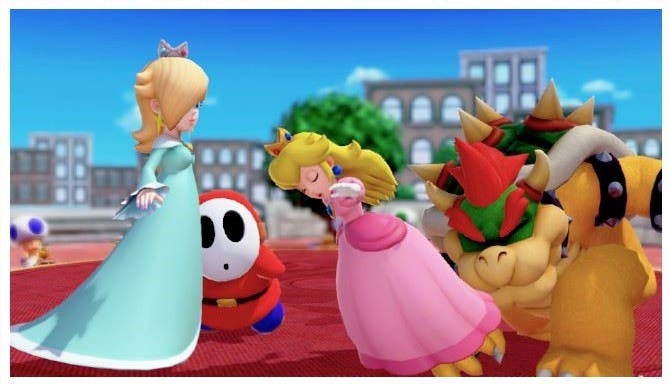
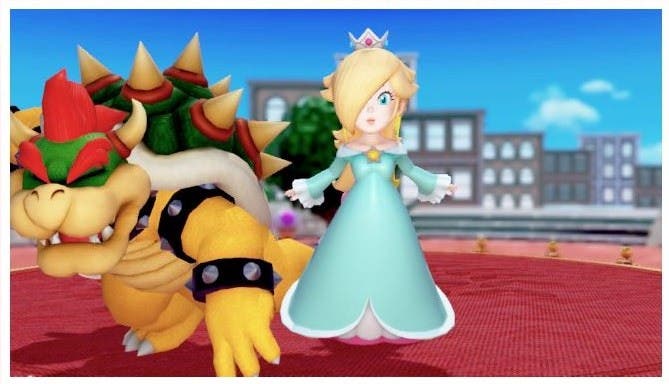

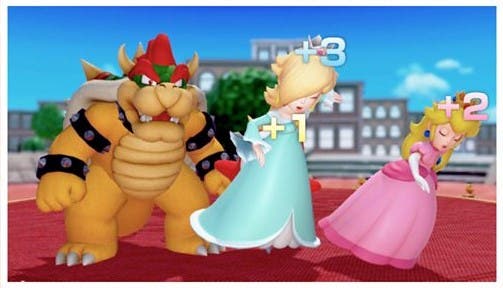


The best minigames are those that use the Joy-Con motion controls effectively. From tilting a jar of candy to empty the sweets out, to flipping a cube of meat in a frying pan, they're uncomplicated yet feel distinctly Nintendo - if you can call it that. Of course, this Mario Party adds a new dimension to the minigame collection with the introduction of rhythm games.
The Sound Stage mode, although a little gimmicky, offers a quick-fire round of gaming - and the rhythm game idea makes perfect sense. Although I'd class myself as an experienced hand at rhythm games, I found many of the Mario Party rhythm minigames pretty challenging. On a lower level, they're extraordinarily satisfying - who knew hitting a baseball in time to Mario music could be so rewarding? With a higher difficulty, I found myself frantically shaking the controller to keep time, which bordered on the comical. I got some strange looks in the office.

Another new mode, River Survival, has proven a little less popular in the Eurogamer office. The four player co-op is new to the Mario Party series and places emphasis on teamwork as you raft down river rapids. There are options to choose which routes and which obstacles you face, and play minigames to improve the speed of your run. Maybe we're all just horribly competitive, but the consensus among my test group was this mode doesn't give players enough motivation to do well. With no versus matches, the minigames and larger mode are essentially a time trial: but this didn't really provide sufficient tension, and the mode felt like it dragged on for considerably longer than necessary.
That being said, River Survival still provided us with a lot of silliness. Despite the snarky comments, most of us in the room were laughing - even if it was due to the suspicious hand gestures we were making in order to row along.
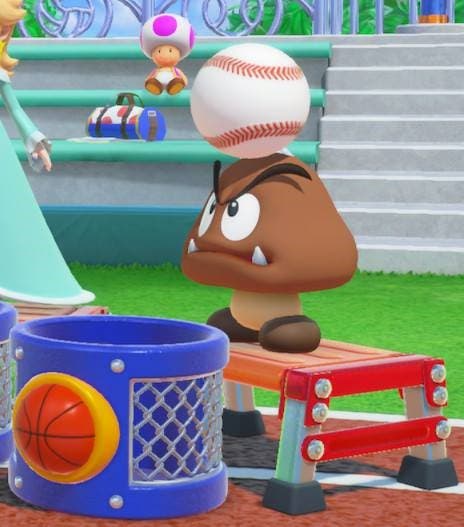
And that sums up Super Mario Party. It's not perfect, but it does have charm. Toad's Rec Room, the new two-tablet mode which I've previously discussed, is one of the most magical gaming experiences I've had in recent years. More generally, there's also lovely attention to detail and a self-aware sense of humour across the game. If one player forgets to join in a group high-five, the other characters will all glare at the forgetful team member. Goomba's animations, too, are just ridiculous: the poor little critter doesn't have any arms, so he just balances items on his head. Of course.
It has its issues, but Super Mario Party still delivers a solid and dependable multiplayer experience. Would I drop everything to rush out and buy it? Probably not - but if you need some light entertainment to distract your Christmas guests, you could certainly do a lot worse.
